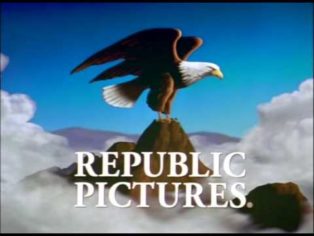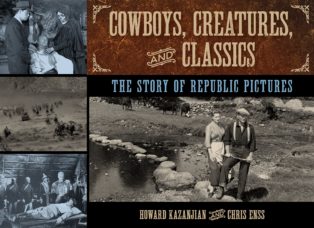Enter now to win a copy of
Foreword Magazine’s Book of the Year Winner,
Cowboys, Creatures and Classics: The Story of Republic Pictures

Republic Pictures was arguably the most important and influential studio in the history of the B movie. During the Golden Age of Hollywood, the studio flourished, and the low-budget commercial movies produced in mass made Republic a profitable concern. Herbert Yates enjoyed the financial reward for the B pictures his studio produced but lacked the respect studio heads like MGM’s David O’Selznick or Fox’s Darryl Zanuck had. It took a considerable amount of talent and innovation to make a B movie, and Yates employed an exceptional team of cinematographers, stuntmen and stuntwomen, and special effects artists to achieve the finished product. Despite the skill and invention needed to create the product, such films were generally considered inferior. Yates wanted to experience the admiration other film companies such as Paramount Pictures and United Artists received. It drove him to increase Republic’s feature film investments.
In the late 1930s, Yates decided to raise the status of the company. He wanted a better product coming out of the studio. He wanted to make an “A” picture. Yates needed a large budget, bankable stars, and a quality script to realize his vision. He believed he could begin gaining the respectability he longed for by developing a project entitled Man of Conquest. He poured considerable resources into the project. Man of Conquest, the fictionalized action biopic of Sam Houston, was Republic’s first A film.
Directed by George Nichols Jr. and starring Richard Dix and Joan Fontaine, the estimated budget for the movie was one million dollars. Man of Conquest was inspired by Marquis James’ Pulitzer Prize–winning book The Raven. New York film critics announced that Man of Conquest was a “thrilling drama skillfully splashed across a broad canvas.” The April 28, 1939, article found in the Brooklyn Daily Eagle praised the direction of the film noting that it “never loses track of its hero or allows its social message to become bigger than its story.” William Boehnel, film reviewer for the New York World Telegram, wrote that Man of Conquest was a “rousing, spectacular blend of Americanism and adventure which not only sounds the clarion call of freedom and democracy in high, resounding notes but related its message of liberty and the right of men to govern himself in a vigorous, colorful, thrilling manner.”
Herbert Yates was pleased Man of Conquest had done so well. The film was nominated for three Academy Awards: Best Art Direction, Best Sound Recording, and Best Original Score. The nominations were proof that Republic Pictures had what it took to develop a project to rival the bigger studios. Industry leaders acknowledged Yates’ effort, and he pledged to produce additional, bigger budget films. Those bigger films were to be done on a limited basis.
Yates was proud of the studio’s reputation for being a dominant force in serials. Not only was Republic good at it, but they also made a substantial amount of money, and financial success was even more important to Yates than respectability as an A movie studio.
Yates wanted to continue building the sales organization as well as creating bigger budget films. He believed a healthy balance of both would elevate the status of the company. In early 1939, he hired James Grainger, the former head of distribution for Fox and Universal Studios. Grainger immediately embarked on a series of meetings with theatrical distributors and exhibitors throughout the nation. He authorized the purchase of franchise distributors and established Republic’s own theatrical distribution system. Grainger was exceptional at his job. Within a year, he increased the number of exhibitors (theaters) to more than nine thousand. The number of theaters showing Republic Studios’ motion pictures grew even higher with each high-budget film and big-name cast member released. By the end of 1939, a mere four years after Herbert Yates founded the company, Republic was showing a profit of $4,742,175. Industry papers such as Variety and the Hollywood Reporter predicted the studio would “wind up a top flight major.”


